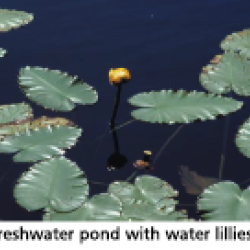Source Institutions
Source Institutions
Add to list Go to activity
Activity link broken? See if it's at the internet archive

In this activity, learners create a freshwater ecosystem in a large plastic bottle. Learners cut and prepare bottles, then fill with water, aquatic plants, snails and fish. Learners observe their mini-ecosystem over time to see what changes--such as the color of the water, the water temperature, plant growth, and behavior and/or population of the snails or fish. The activity serves as a model for larger freshwater ecosystems such as ponds, lakes, rivers, streams, wetlands, reservoirs and groundwater.
- 10 to 30 minutes
- 1 to 7 days
- $10 - $20 per group of students
- Ages 8 - 18
- Activity, Model, Simulation
- English
Quick Guide
Materials List (per group of students)
- dip net
- dechlorinated or spring water
- large aquarium containing guppies, snails, Elodea and Duckweed
- small containers for offspring
- hammer
- nail
- 2 colorless, rinsed 20-liter soda bottles
- markers
- scissors
- masking tape
- sand
- 3 Elodea plants
- scoop of duckweed
- thermometers
- 2 water snails
- 16-oz clear cup
- 2 guppies
- fish food
- magnifying lenses
- student journals and writing tools
Subjects
-
Earth and Space Science
-
Earth Structure
- Oceans and Water
-
Earth Structure
-
Life Sciences
-
Diversity of Life
- Plants
- Animals
-
Ecology
- Ecosystems
- Populations
- Biodiversity
-
Diversity of Life
-
The Nature of Science
-
The Scientific Process
- Asking Questions
- Conducting Investigations
- Gathering Data
- Formulating Explanations
- Communicating Results
-
The Scientific Process
Audience
To use this activity, learners need to:
- see
- read
- touch
Learning styles supported:
- Involves teamwork and communication skills
- Involves hands-on or lab activities
Other
Components that are part of this resource:
Includes alignment to state and/or national standards:
This resource is part of:
Access Rights:
- Free access
By:
Source Collection
- Science After School Consumer's Guide
Rights:
- All rights reserved, State of New Jersey, 2006
Funding Source:
- No Child Left Behind Act of 2001
